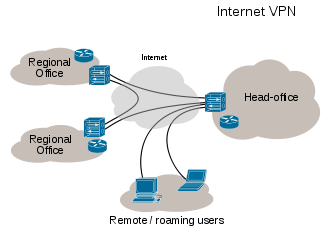In Microsoft Windows Server 2003, core networking tasks are accomplished by using TCP/IP. TCP/IP consists of a suite of protocols, of which TCP and IP are two. This suite of protocols was originally designed to solve a communications problem among the branches of the United States military. In the 1960s, each of the military branches obtained bids from different vendors to provide computer systems for their branch. The Army chose Digital Equipment Corporation (DEC), the Air Force chose International Business Machines (IBM), and the Navy chose Unisys. Soon after, the military branches discovered that they needed their computer systems to communicate with each other to facilitate coordination between the military branches. The Department of Defense (DoD) launched a research project in 1969 to connect the systems of various vendors together to form a network of networks. The DoD developed TCP/IP with IP version 4 (IPv4) to connect this network of networks — the collection of networks now known as the Internet. TCP/IP is still used to connect business networks across the world.
The word internetwork refers to multiple TCP/IP networks connected with routers. The Internet is a worldwide public IP internetwork. An intranet is a private IP internetwork.
The core networking components protocol, TCP/IP, which is installed by default on computers that run Windows Server 2003 is an industry-standard suite of protocols designed for large internetworks spanning wide area network (WAN) links. TCP/IP in Windows Server 2003 was designed to make it easy to integrate Microsoft systems into large-scale corporate, government and public networks, and to provide the ability to operate over those networks in a more secure manner. There are two versions of TCP/IP available for use with Windows Server 2003:
TCP/IP version 4 (with IPv4) and
TCP/IP version 6 (with IPv6).
Computers that run Windows operating systems use TCP/IP to communicate with other computers in corporate intranets, and across the Internet. As such, TCP/IP is an essential component of any Windows network configuration. Windows Server 2003 is the first release of the Windows operating system that includes IPv6. Ideally, IPv6 is used in a pure environment, meaning an environment where IPv6 is the exclusive Internet protocol used between computers. Currently, however, pure IPv6 environments are attainable only when you use computers running Windows operating systems that support IPv6 and routers that support IPv6 routing. As IPv6 replace IPv4, pure IPv6 environments will eventually replace IPv4. Until that occurs, the transition technologies described in this technical reference can be used to facilitate coexistence and provide a migration path from IPv4 to IPv6.

Your Friend

- Manpreet Singh Bindra
- PATIALA, PUNJAB, India
- Please Give Your Valuable Feedback manpreetsinghbindra@hotmail.com
Search Of Your Interest
4G Technology
(1)
AIRTEL Success Story
(1)
AREA NETWORKS
(1)
Apple 3G iPhones Improving Networking
(1)
BSNL DATAONE broadband disconnect problem
(1)
Basic Concept Of TELECOMMUNICATIONS SYSTEM
(1)
Basic and Simple Definition to 3G
(1)
Business Network
(1)
Business Strategy for Growth
(1)
Business Wireless Planning Strategy
(1)
CCTV IP camera
(1)
CISCO : how IGRP make large INTERNETWORKS in organizations
(1)
CISCO Solutions Provide
(1)
CTT6800+ -JPEG 2000 Compressed Transport Transceiver
(1)
Change of IP Address
(1)
Connectionless packet switching and routing
(1)
Core Network of 3G
(1)
Core Networking In MICROSOFT WINDOWS SERVER 2003
(1)
Current Protocols Essential Laboratory Techniques (CPET)
(1)
Difference between 2G - 3G - 4G & What is 4G & its Advantages ?
(1)
Different Business Networking Types
(1)
DirectX proportional to Networking
(1)
FREE Wi-Fi
(1)
Finisar :Traffic Generation
(1)
Fox Business Network
(1)
GPRS Core Network
(1)
HBR Technologies (HBR)
(1)
HOW TELEPHONE NETWORK SYSTEM WORKS
(1)
History of packet switching
(1)
How To Setup Wireless Connection(APPLY SAFETY SETTINGS FIRST)
(1)
How to Network 2 Computers Without a Hub or Router
(1)
How to Use a Wireless Network Connection with a Windows XP Portable Computer at Home and Work
(1)
How to make a proper website on NETWORKING
(1)
How to troubleshoot wireless network connections in Windows XP Service Pack 2
(1)
IP Addresses
(1)
Importance of BANDWIDTH in DSL Internet Connections
(1)
Internet and its Component
(1)
Introduction to LAN
(1)
Is Your Networking Caught A Virus?
(1)
Long Term Evolution (LTE)
(1)
MICROSOFT the WORLD WIDE LEADER in NETWORKING
(1)
Multi-Core Processing
(1)
Multi-core networking
(1)
NETWORKING CORE
(1)
NETWORKING IN MEDICAL APPLIANCES
(1)
NORTELVisitor-Based Networking Solution
(1)
Network Design
(1)
Network Protocols
(1)
Nokia Dual Sim Phones
(1)
OPTICAL CHARACTERISTICS OF LEDS
(1)
Packet switching in networks
(1)
Pressure Swing Adsorption(PSA)
(1)
Proxy Servers HIDE IP address from WEB NOT other INFORMATION
(1)
Purpose of Business Network or Networking
(1)
Role of EGP and BGP in the TCP/IP (Exterior Routing Protocols)
(1)
SOLUTION Providers to NETWORK Companies
(1)
STP topology of a Switched Network
(1)
STRUCTURED CABLES IN TELECOMMUNICATION
(1)
SeaTalk NG network
(1)
Setting Priorities for Next-Generation Web Apps - MICROSOFT
(1)
Social Network Services
(1)
Social Networking Services to Expand Business
(1)
Speed UP Your PC in 3 Easy Steps
(1)
Spyware affecting Networking
(1)
Sysinternals File and Disk Utilities
(1)
Sysinternals Networking Utilities
(1)
Sysinternals Security Utilities
(1)
TENA and NetAcquire
(1)
UNIX Network Security Architecture
(1)
WAN and Home Networking
(1)
What Network Administrators Think of NETWORKS
(1)
What Nortel Solutions can Provide? Case Study
(1)
Why Not Reserved IPs on Internet
(1)
WiMAX
(1)
Wireless Code Division Multiple Access (CDMA)
(1)
koollage-blogs-news
(1)
~ (DDBMS) DISTRIBUTED DATABASE MANAGEMENT SYSTEM
(1)
~ ActiveVideo system
(1)
~ Advanced Shellcoding Techniques
(1)
~ Cisco VTP: VLAN Trunking Protocol
(1)
~ Features of the Web
(1)
~ How Core Networking Solve Problems?( Solutions provided by Core Networking)
(1)
~ Modulation Techniques for Wireless
(1)
~ Trillium Multi-Core Software
(1)
~ Wi-Fi Networking News
(1)
Core Networking

Core Networking In Microsoft Windows Server 2003
Subscribe to:
Post Comments (Atom)


0 comments:
Post a Comment